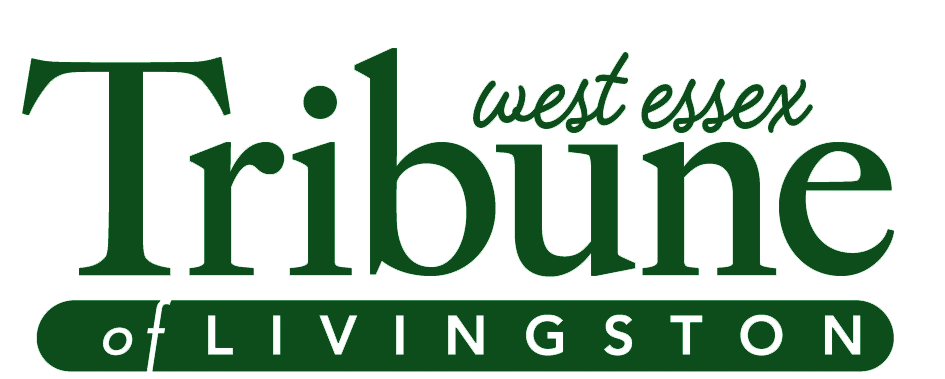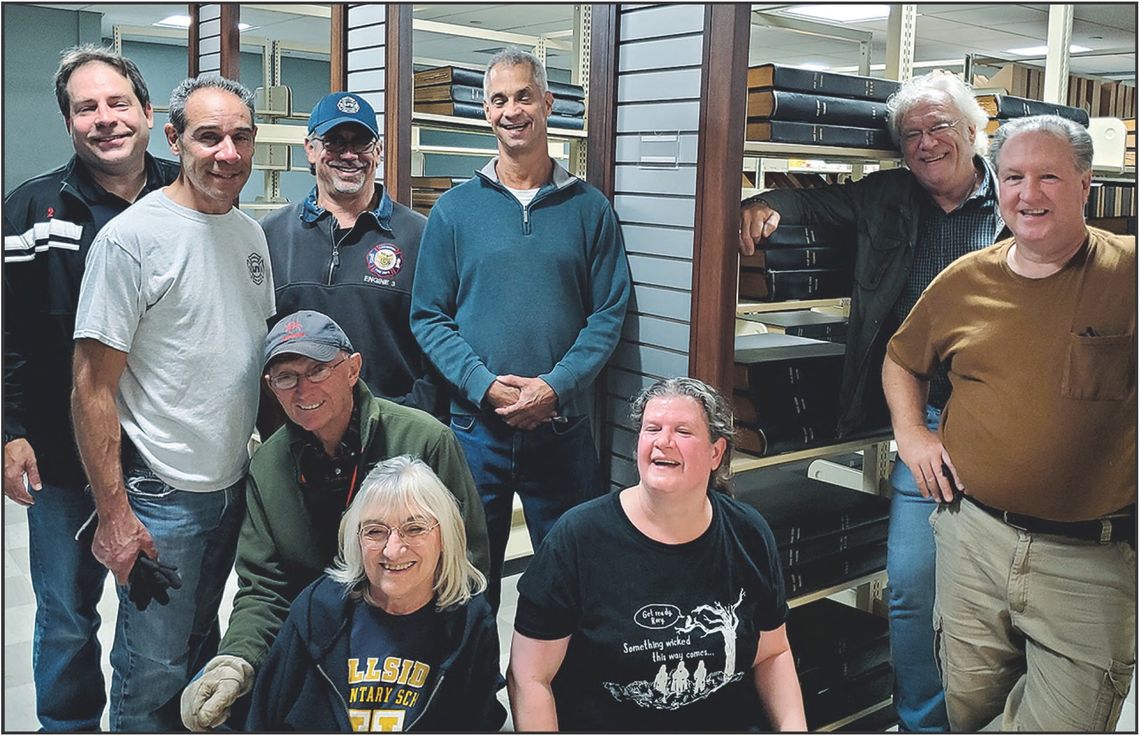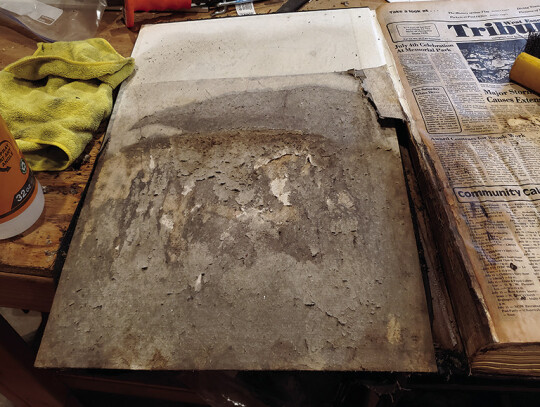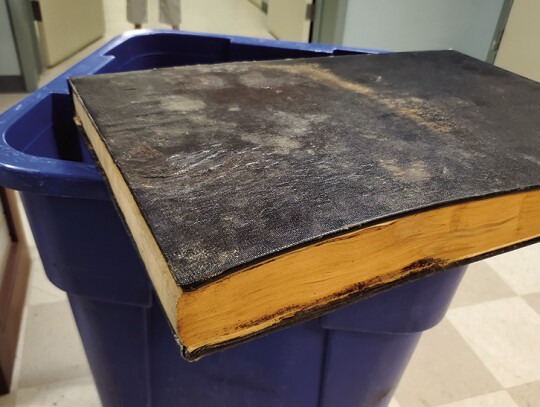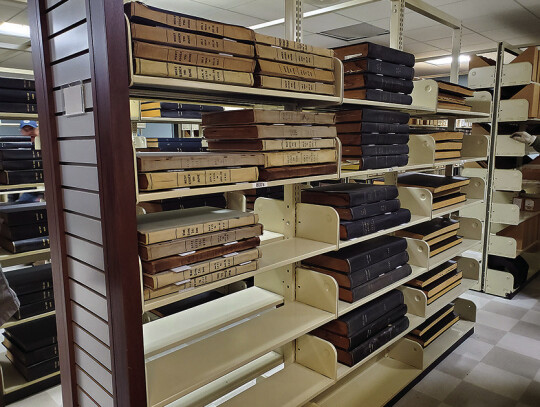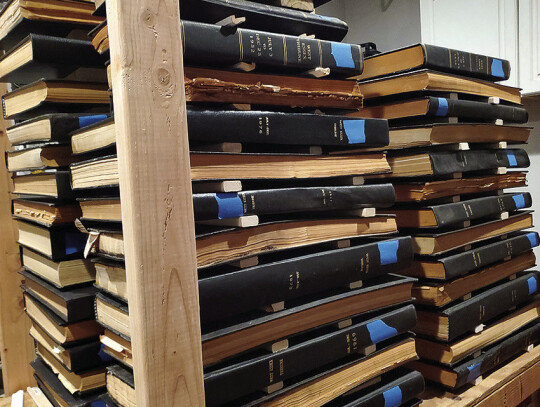A year-long project to remediate mold damage on dozens of West Essex Tribune bound copies by Livingston Fire Department president Tom Cooney and numerous helpers has been completed.
“The Eagle Has Landed!” Cooney announced recently in an email to the Tribune. The last of the newspaper’s bound copies that had been in Cooney’s care at the Camuso Holiday Display storage bam, had been moved back to the Livingston Public Library after undergoing a year’s worth of painstaking remediation.
The journey had begun in late August of 2022, when the Tribune received an email from Library director Amy Babcock-Landy, noting that dozens of books containing bound copies of the newspaper had become the victims of a massive mold spread. She expressed her belief that the books - which contain original hard copies of every single issue of the Tribune dating from its very first issue in 1929 - were beyond saving, and warned that she was preparing to throw them out.
It would have been a devastating loss to the Tribune, whose staff relies on the hard copies for historical research and photos.
As it turned out, Cooney had also been heavily relying on the bound Tribune copies as he prepared his comprehensive written and pictorial history of the Livingston Fire Department. Upon learning of the mold damage, he immediately volunteered to save each and every affected book. “We’ll do whatever it takes to preserve the books,” he told Tribune publisher Jenny Chciuk “They are way too valuable to lose. The history of Livingston is in these pages!”
Cooney and volunteers recruited from the Camuso Holiday Display Committee (which Cooney heads as the “Chief Elf”) immediately went to work to save the damaged volumes. The heavy volumes were transported to the Camuso storage barn at Memorial Park, where there was safety storage space and room to work.
A Year-Long, Multi-Step Process The process began with an assessment. Each volume was examined, and moisture meter readings conducted on each book. A spreadsheet was created to document the condition of each book. Those volumes needing the most remediation were marked with painter’s tape.
Next came the drying process. Spacers were inserted between volumes for proper airflow. Books were stacked in columns with oscillating fans on two corners. These fans were on continuously for nearly six months, with periodic spot checks made of moisture readings. The wettest volumes were separated and opened, with additional fans positioned to thoroughly dry pages, covers, and spines. Those with the most visible mold were separated from the others to prevent further mold spread.
The cleaning began once all the books were sufficiently dried. Although 80 percent of the volumes showed no visible signs of mold, all volumes were cleaned, with the assumption that they might have been in contact with moldy volumes.
The volumes with the most mold visible were wrapped in plastic, taped tightly, and frozen for 72 hours each to kill the spores. Once they were removed from the freezer, the mold was brushed off outdoors and the books wiped clean.
Each book was then cleaned like all the other volumes. This involved spraying or soaking covers, spines, and inside covers with hydrogen peroxide and scrubbed with bristle brushes. They were then wiped down with clean cloths and set up with fans to thoroughly dry out again.
The process was then repeated twice more, with the volumes treated next with alcohol and then with Mold Armor, commercial mold and mildew killing agent.
The Mold Armor, however, was not used on older cloth volumes to avoid damage. Luckily, none of the cloth volumes (dating from 1929 through the 1940s) had any visible mold.
“Surgical” Repairs The most damaged volumes required “surgery” in many cases, Cooney reported. In a few (luckily, less than ten), the mold had spread to the inside of the covers and onto some pages as well as the page stack edges. The inside paper overlays of those volumes were carefully cut and removed. The cardboard covers that had mold growth were soaked in alcohol and then carefully scraped down to remove the mold.
Once cleaned, the cardboard was again soaked in alcohol to kill any residual mold or spores. These areas were thoroughly dried and new paper covers were glued on. The page edge stacks that had mold visible were carefully cut using an Exacto knife and a straight edge to remove the contaminated edges. Fortunately, this did not result in the loss of any text, due to the large borders.
Areas where vinyl covers had to be cut and peeled back to remove mold and repair the cardboard cover itself, were later re-glued, and the cut seams sealed with specialized book repair tape. “As luck would have it, the only pages that had to be completely removed due to damage were ads at the back of the final editions in a few of the books, so no article text or photos were lost,” said Cooney.
Older cloth cover volumes from the 1930s were mechanically repaired to prevent the page stacks from coming apart from the spine when opened. The original construction used steel nails hammered through the pages. The repairs were done using modern rink shank nails used in flooring installation from the top and bottom of the page stacks, ensuring they cannot pull apart.
Cooney explained that the mold microspores are likely embedded deeply in the material, but they should not activate or become airborne unless the books’environment changes – for example, if the books get wet again, or are stored in dampness with no air flow.
“Apart from those few still being repaired, the volumes have all been returned to the library and are available for research projects,” noted Cooney. “Those still undergoing ‘surgery’will be returned when they are completed. The area the library staff cleared to hold them all in one space is dry with very good air movement. They are now stacked using plastic spacers between each book to provide sufficient air flow, which should ensure the mold issue does not return. I’d like to say a special thank you to Amy Babcock, Jessica Voitko, and Melissa Brisbin for their assistance and facilitating the return of the books.”
It was, he said, “a very long and messy process, but the result was saving these historic books, hopefully for generations to come.”
Those who worked on the project with Cooney included Mike Neary, Pat Ippolito, Jim Kedrie, Mike Stolfi, Lance Rogers, Jay Isherwood, Cathy Fitzpatrick, Sondra Hantman,Adam Hantman, Nancy Dinar, Paul Engledrum, Tim Foley, and Dan Goldman, all members of the Camuso Display Committee.
